被动语态专练(简单)教学提纲
被动语态教学案
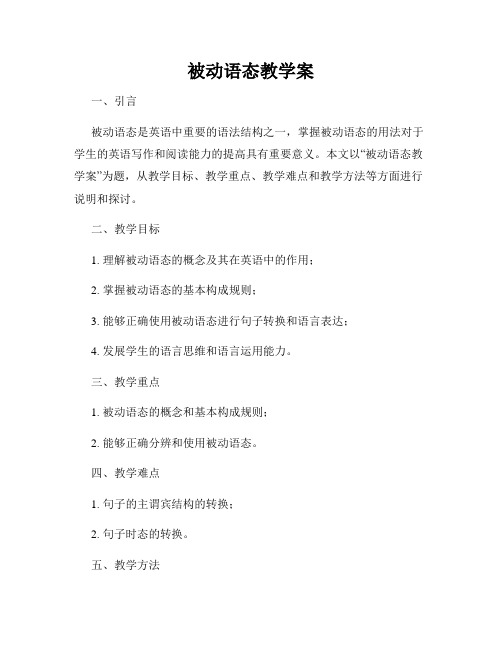
被动语态教学案一、引言被动语态是英语中重要的语法结构之一,掌握被动语态的用法对于学生的英语写作和阅读能力的提高具有重要意义。
本文以“被动语态教学案”为题,从教学目标、教学重点、教学难点和教学方法等方面进行说明和探讨。
二、教学目标1. 理解被动语态的概念及其在英语中的作用;2. 掌握被动语态的基本构成规则;3. 能够正确使用被动语态进行句子转换和语言表达;4. 发展学生的语言思维和语言运用能力。
三、教学重点1. 被动语态的概念和基本构成规则;2. 能够正确分辨和使用被动语态。
四、教学难点1. 句子的主谓宾结构的转换;2. 句子时态的转换。
五、教学方法1. 演示法:通过教师的亲自示范和演示,使学生熟悉被动语态的使用;2. 情景创设法:通过情景或实际例子的引导,让学生能够理解和运用被动语态;3. 练习法:设计一系列练习和活动,巩固学生对被动语态的掌握。
六、教学过程第一步:导入通过师生对话的形式,引导学生回顾并复习主动语态,从而引出被动语态的概念和作用。
第二步:讲解被动语态的基本构成规则1. 被动语态的构成:be动词 + 过去分词2. 被动语态的时态变化:be动词的时态变化,过去分词的保持不变第三步:例句分析和练习1. 通过例句分析,引导学生理解被动语态的使用方法;2. 给学生一些例句进行转换练习,培养学生对被动语态的运用能力。
第四步:巩固练习设计一系列巩固练习,如填空、句子转换等,逐步加大难度,巩固学生对被动语态的掌握和运用。
第五步:交流和展示学生可以小组合作,互相交流和展示自己对被动语态的理解和应用。
教师可以给予评价和指导。
七、教学总结通过以上的教学过程,学生可以初步理解被动语态的概念,掌握被动语态的基本构成规则,并能够正确地运用被动语态进行句子转换和语言表达。
同时,通过情境创设和练习活动,学生的语言思维和语言运用能力也得到了一定的发展。
八、课后作业布置一些与被动语态相关的练习题,要求学生通过实际运用巩固和强化所学内容。
中考被动语态专项复习课教案
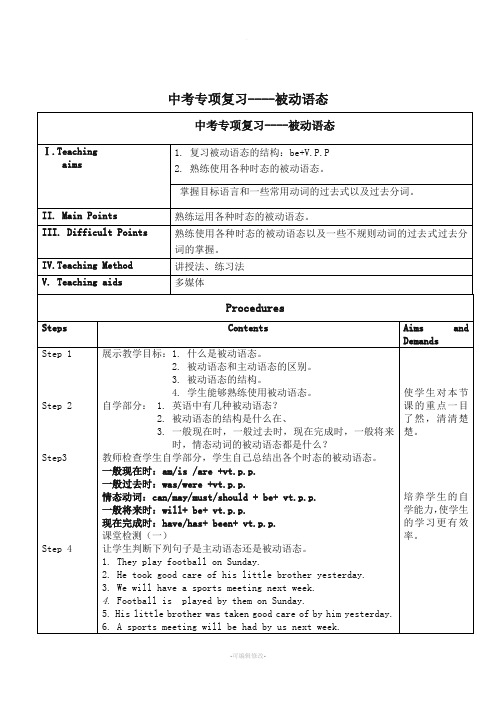
一般将来时:will+ be+ vt.p.p.
现在完成时:have/has+ been+ vt.p.p.
课堂检测(一)
让学生判断下列句子是主动语态还是被动语态。
1.They play football on Sunday.
2. He took good care of his little brother yesterday.
2. Now people can use computers to help them.
Now computers _______ ______ ______ to help them.
3.I found the ticket on the floor.
______ ______ ______ ______ on the floor.
e.g. He gives me a flower everyday.
被动1 I am given a flower by him everyday.
被动2 A flower is given to me by him everyday.
通过几道练习题让学生熟练。
使学生对本节课的重点一目了然,清清楚楚。
现在完成时:have/has+ been+ vt.p.p.
THANKS
致力为企业和个人提供合同协议,策划案计划书,学习课件等等
打造全网一站式需求
欢迎您的下载,资料仅供参考
4.He will mend the bike tomorrow.
The bike ______ ______ _______ in two days.
初中被动语态详细讲解教学提纲
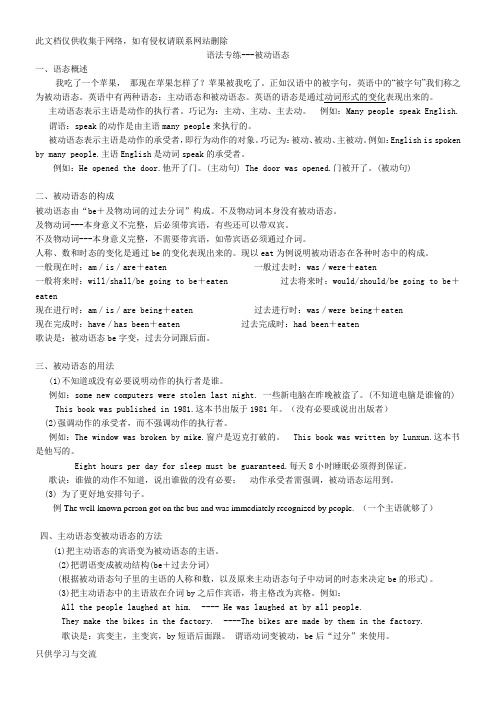
语法专练---被动语态一、语态概述我吃了一个苹果,那现在苹果怎样了?苹果被我吃了。
正如汉语中的被字句,英语中的“被字句”我们称之为被动语态。
英语中有两种语态:主动语态和被动语态。
英语的语态是通过动词形式的变化表现出来的。
主动语态表示主语是动作的执行者。
巧记为:主动、主动、主去动。
例如:Many people speak English.谓语:speak的动作是由主语many people来执行的。
被动语态表示主语是动作的承受者,即行为动作的对象。
巧记为:被动、被动、主被动。
例如:English is spoken by many people.主语English是动词speak的承受者。
例如:He opened the door.他开了门。
(主动句) The door was opened.门被开了。
(被动句)二、被动语态的构成被动语态由“be+及物动词的过去分词”构成。
不及物动词本身没有被动语态。
及物动词---本身意义不完整,后必须带宾语,有些还可以带双宾。
不及物动词---本身意义完整,不需要带宾语,如带宾语必须通过介词。
人称、数和时态的变化是通过be的变化表现出来的。
现以eat为例说明被动语态在各种时态中的构成。
一般现在时:am/is/are+eaten 一般过去时:was/were+eaten一般将来时:will/shall/be going to be+eaten 过去将来时:would/should/be going to be+eaten现在进行时:am/is/are being+eaten 过去进行时:was/were being+eaten现在完成时:have/has been+eaten 过去完成时:had been+eaten歌诀是:被动语态be字变,过去分词跟后面。
三、被动语态的用法(1)不知道或没有必要说明动作的执行者是谁。
例如:some new computers were stolen last night. 一些新电脑在昨晚被盗了。
被动语态教案
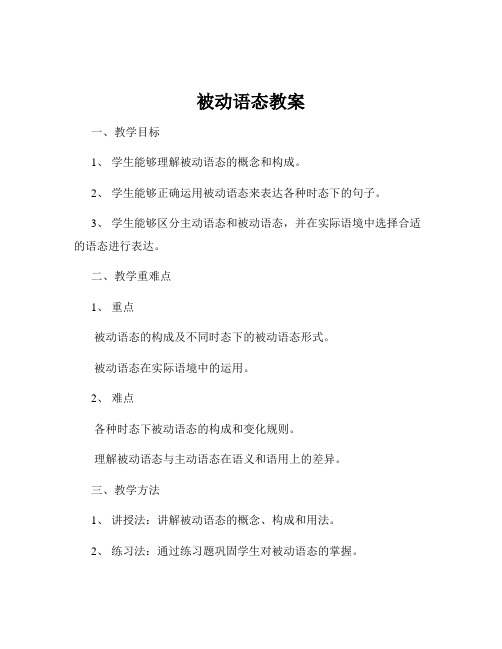
被动语态教案一、教学目标1、学生能够理解被动语态的概念和构成。
2、学生能够正确运用被动语态来表达各种时态下的句子。
3、学生能够区分主动语态和被动语态,并在实际语境中选择合适的语态进行表达。
二、教学重难点1、重点被动语态的构成及不同时态下的被动语态形式。
被动语态在实际语境中的运用。
2、难点各种时态下被动语态的构成和变化规则。
理解被动语态与主动语态在语义和语用上的差异。
三、教学方法1、讲授法:讲解被动语态的概念、构成和用法。
2、练习法:通过练习题巩固学生对被动语态的掌握。
3、情境教学法:创设真实的语言情境,让学生在情境中运用被动语态。
四、教学过程1、导入展示一些主动语态的句子,如:“The boy kicks the ball” 然后将其改为被动语态:“The ball is kicked by the boy” 引导学生观察句子结构的变化,从而引出被动语态的概念。
2、知识讲解解释被动语态的定义:当主语是动作的承受者时,使用被动语态。
讲解被动语态的构成:“be +过去分词”,其中 be 动词根据时态和主语的人称、数进行变化。
详细讲解不同时态下的被动语态形式:一般现在时:am/is/are +过去分词一般过去时:was/were +过去分词一般将来时:will be +过去分词现在进行时:am/is/are being +过去分词过去进行时:was/were being +过去分词现在完成时:have/has been +过去分词过去完成时:had been +过去分词3、示例练习给出一些主动语态的句子,让学生将其改为被动语态,并进行全班交流和纠正。
例如:“They clean the room every day” 改为“The room is cleaned by them every day”4、语境运用创设一些实际的语言情境,如描述学校的日常活动、家庭中的事情等,让学生用被动语态进行描述。
例如:“The books are borrowed from the library by the students”5、小组活动学生分组,进行小组讨论。
被动语态复习课(共5篇)
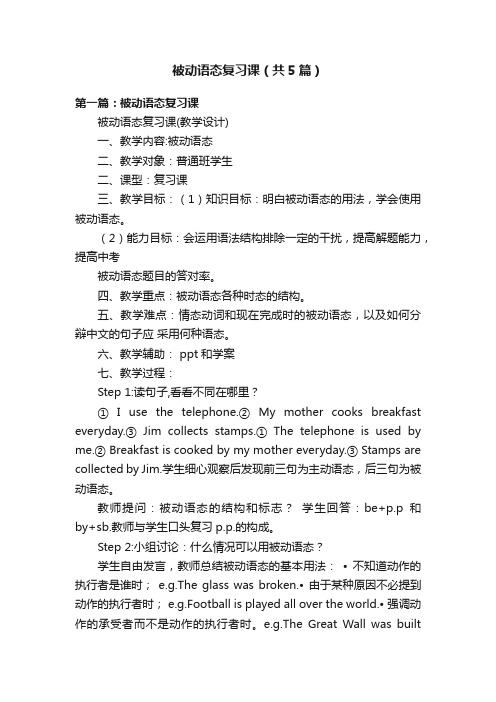
被动语态复习课(共5篇)第一篇:被动语态复习课被动语态复习课(教学设计)一、教学内容:被动语态二、教学对象:普通班学生二、课型:复习课三、教学目标:(1)知识目标:明白被动语态的用法,学会使用被动语态。
(2)能力目标:会运用语法结构排除一定的干扰,提高解题能力,提高中考被动语态题目的答对率。
四、教学重点:被动语态各种时态的结构。
五、教学难点:情态动词和现在完成时的被动语态,以及如何分辩中文的句子应采用何种语态。
六、教学辅助: ppt和学案七、教学过程:Step 1:读句子,看看不同在哪里?① I use the telephone.② My mother cooks breakfast everyday.③ Jim collects stamps.① The telephone is used by me.② Breakfast is cooked by my mother everyday.③ Stamps are collected by Jim.学生细心观察后发现前三句为主动语态,后三句为被动语态。
教师提问:被动语态的结构和标志?学生回答:be+p.p和by+sb.教师与学生口头复习p.p.的构成。
Step 2:小组讨论:什么情况可以用被动语态?学生自由发言,教师总结被动语态的基本用法:• 不知道动作的执行者是谁时;e.g.The glass was broken.• 由于某种原因不必提到动作的执行者时;e.g.Football is played all over the world.• 强调动作的承受者而不是动作的执行者时。
e.g.The Great Wall was builtlong long ago.Step 3:举例子,分析题目(时态,单复数),发现规律,使用学案作总结。
1.一般现在时:They make shoes in that factory.→Shoes are made(by them)in that factory.总结: 一般现在时被动语态结构为am/is /are +p.p.完成《学案》选择题1、2 2.一般过去时They bought ten computers last term.→Ten computers were bought(by them)last term.总结: 一般过去时被动语态结构为was /were +p.p.完成《学案》选择题3、43.一般将来时(含will)They will finish the work tomorrow.→The work will be finished(by them)tomorrow.总结: 一般将来时被动语态结构为will+be +p.p.完成《学案》选择题5、6 4.现在完成时:(have/has+p.p.)Danny has finished the project.→The project has been finished(by Danny).总结: 现在完成时被动语态结构为have/has+been +p.p.完成《学案》选择题7、8 5.含情态动词(must, should, may, can, could, might…)Amy can make a cake .→A cake can be made(by Amy).总结: 含情态动词被动语态结构为情态动词+be +p.p.完成《学案》选择题9、10 Step 4:教师提出:take place, happen, belong to无被动语态;商场开业(open)无须用被动语态。
最新高中英语语法被动语态教学提纲

高中英语语法-被动语态一.定义语态(voice)表示主语与谓语动词之间的关系。
当主语是动作的动词用(Active V oice);如果主语是动作的,动词便用(Passive V oice)。
被动语态由be+及物动词的过去分词构成。
二.考点:考查时态和语态的掌握、与主谓一致连考题型:①②例1.The problem solved and the foreigner got into the taxi.(短文改错)2.Now college graduates (encourage)to start their own business which sounds really good for them.(语法填空)3.Truly elegant chopstics might (make)of gold and silver with Chinese characters.(语法填空)三.做题步骤①判断语态②判断时态③套用具体时态的被动语态形式④注意主谓一致四.各种时态的被动语态形式1) 一般现在时:Subject+ be(am/is/are) +done (过去分词)2)一般过去时:3)一般将来时: Subject+ shall/will/ be going to be done (过去分词)4)过去将来时:5)现在进行时: Subject+ be(am/is/are) being done(过去分词)6)过去进行时:7)现在完成时: Subject+has /have been done8)过去完成时:9)带有情态动词时: Subject+情态动词+be+done (过去分词)五.掌握基础,学以致用(用所给动词适当形式填空)1.Visitors (request) not to take photos here.2. The classroom must (clean) every day.3. I (give) ten minutes to decide whether I studied abroad or not.4. you (invited) to a party held in the sckool hall tomorrow.5. A new cinema (build)here now.6.The manager entered the office and was happy to learn that four-fifths of the tickets _ _.(book)7. A meeting (hold) when I was there.8. ---- Have you moved into the new house?---- Not yet, the rooms ___ __.(paint)9. The letter (receive)already.10. He said a satisfying plan (put) forward next week.六.被动语态与系表结构的区别并非所有的“be+过去分词”都为被动语态;有些为系表结构。
被动语态专项复习教学设计
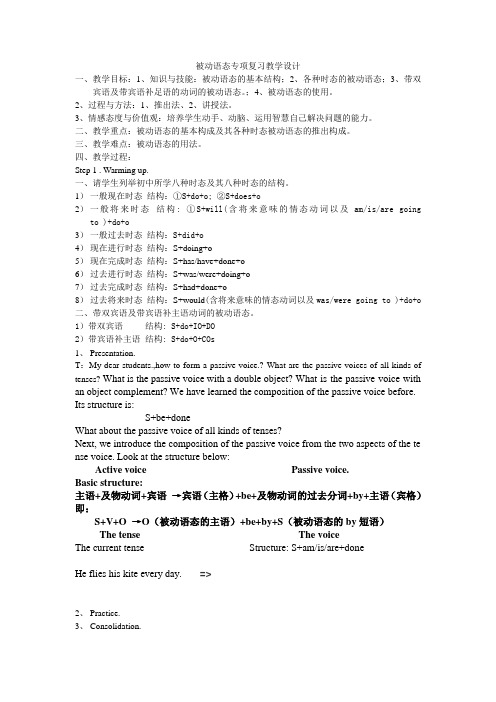
被动语态专项复习教学设计一、教学目标:1、知识与技能:被动语态的基本结构;2、各种时态的被动语态;3、带双宾语及带宾语补足语的动词的被动语态。
;4、被动语态的使用。
2、过程与方法:1、推出法、2、讲授法。
3、情感态度与价值观:培养学生动手、动脑、运用智慧自己解决问题的能力。
二、教学重点:被动语态的基本构成及其各种时态被动语态的推出构成。
三、教学难点:被动语态的用法。
四、教学过程:Step 1 . Warming up.一、请学生列举初中所学八种时态及其八种时态的结构。
1)一般现在时态结构:①S+do+o; ②S+does+o2)一般将来时态结构: ①S+will(含将来意味的情态动词以及am/is/are going to )+do+o3)一般过去时态结构:S+did+o4)现在进行时态结构:S+doing+o5)现在完成时态结构:S+has/have+done+o6)过去进行时态结构:S+was/were+doing+o7)过去完成时态结构:S+had+done+o8)过去将来时态结构:S+would(含将来意味的情态动词以及was/were going to )+do+o 二、带双宾语及带宾语补主语动词的被动语态。
1)带双宾语结构: S+do+IO+DO2)带宾语补主语结构: S+do+O+COs1、Presentation.T:My dear students.,how to form a passive voice.? What are the passive voices of all kinds of tenses? What is the passive voice with a double object?What is the passive voice with an object complement?We have learned the composition of the passive voice before. Its structure is:S+be+doneWhat about the passive voice of all kinds of tenses?Next, we introduce the composition of the passive voice from the two aspects of the te nse voice.Look at the structure below:Active voice Passive voice.Basic structure:主语+及物动词+宾语→宾语(主格)+be+及物动词的过去分词+by+主语(宾格)即:S+V+O →O(被动语态的主语)+be+by+S(被动语态的by短语)The tense The voiceThe current tense Structure: S+am/is/are+doneHe flies his kite every day. =>2、Practice.3、Consolidation.4、Homework.把下列句子改为被动语态:1.He often hits me.2.I do my homework at home.3. He played the piano yesterday.4.Tom helped her with English .5.Lucy will write a letter tomorrow.6.My sister is going to fly the kite7.Chen clean the room the next day.8.Lucy was going to drink coffee9.Linda is washing the dishes now.10. I am watching TV.11.Jack was reading the story at eight yesterday.12.They were planting the trees at this time last year.13. She has just eaten her lunch.14. I have already finished this job.15. She had already made the bed well after I came into the room.。
(简化版)初中被动语态讲解及练习

(简化版)初中被动语态讲解及练习初中被动语态讲解及练(简化版)1. 什么是被动语态?被动语态是英语中的一种语法形式,用来表示动作的接受者或者主语是动作的承受者。
在被动语态中,动作的执行者不再是主语,而是通过by短语提供或省略。
被动语态的基本结构是“be动词+过去分词”。
2. 被动语态的构成被动语态的构成包括以下几个部分:2.1 be动词be动词有不同的形式,取决于时态、语气和人称。
常见的be动词有:- am(第一人称单数)- is(第三人称单数)- are(第二人称和第三人称复数)2.2 过去分词过去分词是一个动词的形式,通常由动词的过去式和-ed或者-en构成。
例如:- watched(观看)- eaten(吃)- written(写)2.3 by短语by短语是可选的,用来表示动作的执行者。
当动作的执行者不重要或者无需提及时,可以省略by短语。
例如:- The book was written by the author.(这本书是作者写的。
)- The bridge was built in 2005.(这座桥是在2005年建成的。
)- The cake was eaten.(蛋糕被吃掉了。
)3. 被动语态的用法被动语态在英语中的使用非常广泛,常见的情况包括但不限于:- 当执行者未知或不重要时,使用被动语态可以强调动作承受者。
例如:The car was stolen.(这辆车被偷了。
)- 当强调动作的结果或者影响时,使用被动语态。
例如:The window was broken.(窗户被打破了。
)- 当主语是长或者复杂的名词短语时,使用被动语态可以使句子更加简洁易懂。
例如:The movie was watched by millions of people.(这部电影被数百万人观看。
)4. 被动语态的练下面是一些被动语态的练题,可以用来提高对被动语态的掌握程度:1. The flowers _______ (water) every morning by my mother.2. The letter _______ (send) to the wrong address by mistake.3. The cake _______ (bake) in the oven for 30 minutes.4. The story _______ (tell) by the teacher in the classroom.5. 总结被动语态是英语中重要的语法形式,它可以改变句子的主动性和表达方式。
(完善版)被动语态复习纲要
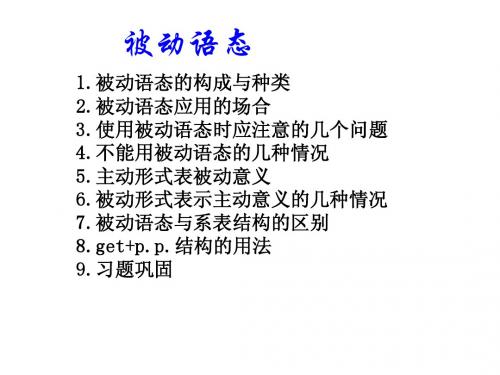
2.被动语态应用的场合: 2.被动语态应用的场合: 被动语态应用的场合 1)为了强调动作的执行者而用by修饰时. 1)为了强调动作的执行者而用by修饰时. 为了强调动作的执行者而用by修饰时 The vase was broken by the boy who lives next door. 2)不知道谁是动作的执行者 不知道谁是动作的执行者, 2)不知道谁是动作的执行者,或没必要指明谁是动作的执行者 时. The book was first published in 1983. Printing was introduced into Europe from China. 3)需要强调或突出动作的承受者或事件本身而不必指明谁是动 需要强调或突出动作的承受者 3)需要强调或突出动作的承受者或事件本身而不必指明谁是动 作的执行者. 作的执行者. These children are taken good care of here. An agreement was arrived at finally. 4)在文章标题 广告、新闻中. 在文章标题、 4)在文章标题、广告、新闻中. It’ It’s reported that only a few have been lost in the earthquake. Girls wanted. (= Girls are wanted.) 招女工 The destroyer is reported to have been sunk.
3)情态动词和be to、 to、 to、 3)情态动词和be going to、be to、be sure to、 情态动词和 to、 to、 better等结构变被动语 used to、have to、had better等结构变被动语 只需将它们后面的动词原形变为be +过去分 态,只需将它们后面的动词原形变为be +过去分 词。 This machine can be repaired in two days. The problem must be solved soon. painted. The room is going to be painted. care. The homework has to be done with care.
被动语态教学设计教案
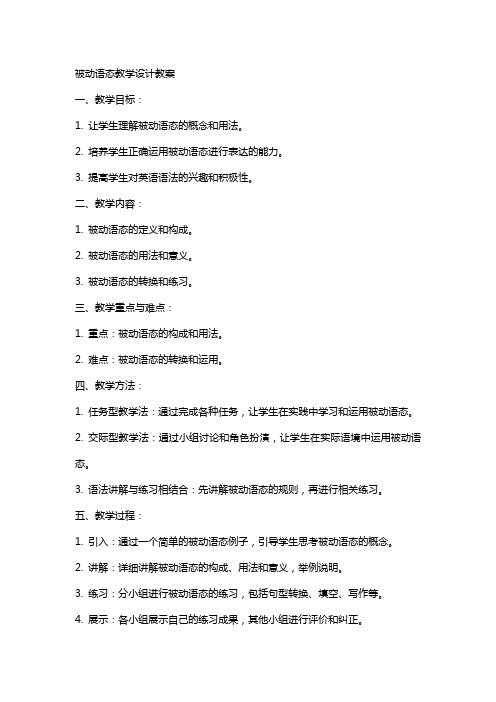
被动语态教学设计教案一、教学目标:1. 让学生理解被动语态的概念和用法。
2. 培养学生正确运用被动语态进行表达的能力。
3. 提高学生对英语语法的兴趣和积极性。
二、教学内容:1. 被动语态的定义和构成。
2. 被动语态的用法和意义。
3. 被动语态的转换和练习。
三、教学重点与难点:1. 重点:被动语态的构成和用法。
2. 难点:被动语态的转换和运用。
四、教学方法:1. 任务型教学法:通过完成各种任务,让学生在实践中学习和运用被动语态。
2. 交际型教学法:通过小组讨论和角色扮演,让学生在实际语境中运用被动语态。
3. 语法讲解与练习相结合:先讲解被动语态的规则,再进行相关练习。
五、教学过程:1. 引入:通过一个简单的被动语态例子,引导学生思考被动语态的概念。
2. 讲解:详细讲解被动语态的构成、用法和意义,举例说明。
3. 练习:分小组进行被动语态的练习,包括句型转换、填空、写作等。
4. 展示:各小组展示自己的练习成果,其他小组进行评价和纠正。
5. 总结:对本节课的内容进行总结,强调被动语态的重要性和运用。
6. 作业:布置相关的被动语态练习,要求学生回家后进行巩固。
六、教学评估:1. 课堂参与度:观察学生在课堂活动中的参与情况,了解他们对被动语态的理解和运用程度。
2. 练习完成情况:检查学生完成练习的情况,评估他们对被动语态知识的掌握。
3. 小组讨论和角色扮演:评估学生在小组讨论和角色扮演中的表现,关注他们如何运用被动语态进行交流。
七、教学拓展:1. 对比主动语态和被动语态:让学生对比两种语态的用法和意义,加深他们对被动语态的理解。
2. 举例子:让学生举例说明被动语态在实际生活中的应用,增强他们对被动语态的感知。
3. 进行跨学科学习:将被动语态与其他学科相结合,如科学、数学等,让学生在不同的领域中学习和运用被动语态。
八、教学资源:1. 教材:选用适合学生水平的英语教材,提供相关的passive voice 知识点和练习。
被动语态教学设计教案
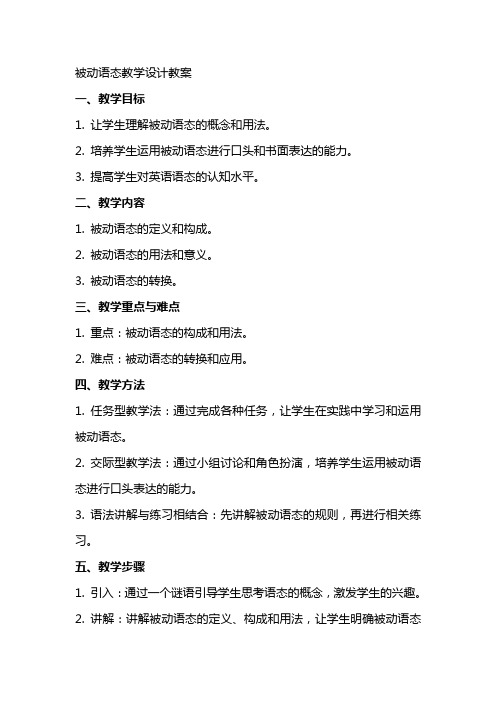
被动语态教学设计教案一、教学目标1. 让学生理解被动语态的概念和用法。
2. 培养学生运用被动语态进行口头和书面表达的能力。
3. 提高学生对英语语态的认知水平。
二、教学内容1. 被动语态的定义和构成。
2. 被动语态的用法和意义。
3. 被动语态的转换。
三、教学重点与难点1. 重点:被动语态的构成和用法。
2. 难点:被动语态的转换和应用。
四、教学方法1. 任务型教学法:通过完成各种任务,让学生在实践中学习和运用被动语态。
2. 交际型教学法:通过小组讨论和角色扮演,培养学生运用被动语态进行口头表达的能力。
3. 语法讲解与练习相结合:先讲解被动语态的规则,再进行相关练习。
五、教学步骤1. 引入:通过一个谜语引导学生思考语态的概念,激发学生的兴趣。
2. 讲解:讲解被动语态的定义、构成和用法,让学生明确被动语态的概念。
3. 练习:分小组进行练习,让学生运用被动语态进行口头表达。
4. 转换:讲解如何将主动语态转换为被动语态,并进行相关练习。
5. 应用:设计一个场景,让学生运用被动语态进行角色扮演。
6. 总结:对本节课的内容进行总结,强调被动语态的重要性和用法。
7. 作业:布置一道关于被动语态的练习题,让学生巩固所学知识。
六、教学评价1. 课堂参与度:观察学生在课堂活动中的参与程度,了解他们对被动语态的理解和应用情况。
2. 练习完成情况:检查学生完成练习的情况,评估他们对被动语态知识的掌握程度。
3. 角色扮演表现:评价学生在角色扮演中的表现,考察他们运用被动语态进行口头表达的能力。
七、教学拓展1. 对比主动语态和被动语态:让学生分析两种语态的差异,加深他们对被动语态的理解。
2. passive voice 与其他语法知识的结合:引导学生探讨passive voice 在不同语法场景中的应用,如条件句、虚拟语气等。
八、教学反思在课后,教师应反思本节课的教学效果,包括学生的学习兴趣、课堂活动的组织、教学难点的处理等方面,以便改进今后的教学。
被动语态专练
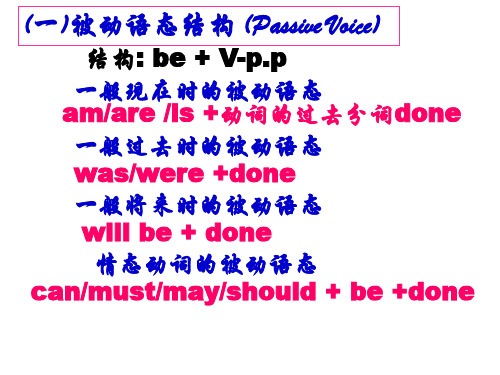
4.The coach makes the players play basketball ten hours a day. are ____ to ___ The players _____ made____play basketball…. 5.She heard the girls talk with each other. were heard _______ talk with…. The girls _______ _______ to (We saw him playing in the street.)
3 He won’t finish his homework in an hour.
His homework won’t be finished …
1We must clean the classroom every day.
The classroom must be cleaned …
2Parents should allow the teenagers to choose their own clothes.
Our studies should be paid attention to.
二、make, see, hear, watch, notice等变被动语态 等变被动语态 必须还原to. (be made/seen/ heard to do) 时,必须还原 1.I often see him come into the room. .
The teenagers should be allowed to… 3 Uncle Wang can’t mend his bike .含情态动词 His bike can’t be mended by Uncle Wang. ______________________________________
被动语态口语练习教学设计教案
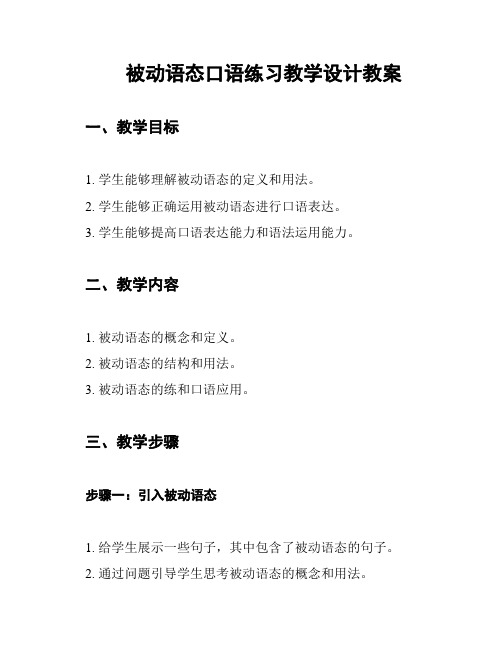
被动语态口语练习教学设计教案
一、教学目标
1. 学生能够理解被动语态的定义和用法。
2. 学生能够正确运用被动语态进行口语表达。
3. 学生能够提高口语表达能力和语法运用能力。
二、教学内容
1. 被动语态的概念和定义。
2. 被动语态的结构和用法。
3. 被动语态的练和口语应用。
三、教学步骤
步骤一:引入被动语态
1. 给学生展示一些句子,其中包含了被动语态的句子。
2. 通过问题引导学生思考被动语态的概念和用法。
步骤二:讲解被动语态的结构和用法
1. 给学生详细讲解被动语态的结构,并和主动语态进行对比。
2. 通过例句和实例解释被动语态的用法,如强调动作的承受者等。
步骤三:练被动语态
1. 给学生提供一些练题,让他们将主动语态的句子转换为被动语态。
2. 分组进行口语练,让学生运用被动语态表达不同的情境和场景。
步骤四:口语应用
1. 设计口语活动或角色扮演,让学生在实际情境中运用被动语态进行口语表达。
2. 提供反馈和指导,帮助学生改进口语表达和语法运用能力。
四、教学评估
1. 学生对被动语态的理解程度。
2. 学生在口语练中的表现和应用能力。
3. 学生对反馈和指导的接受和改进情况。
五、教学资源
1. PowerPoint演示文稿。
2. 练题和口语活动材料。
3. 黑板和白板标记工具。
以上为《被动语态口语练习教学设计教案》的简要内容。
被动语态专练(简单)
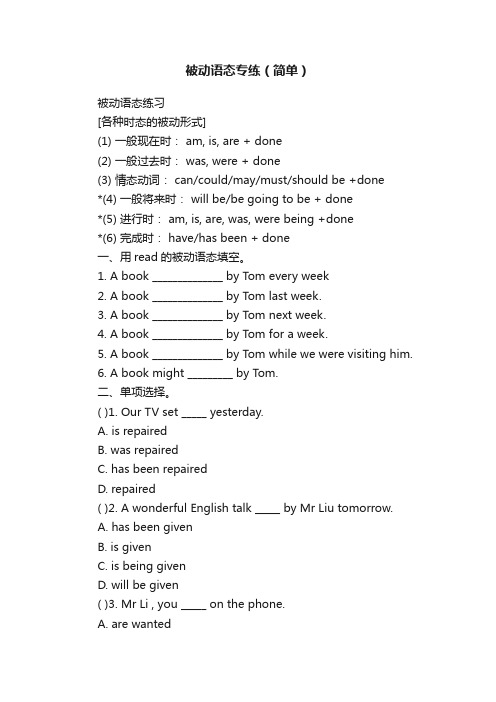
被动语态专练(简单)被动语态练习[各种时态的被动形式](1) 一般现在时: am, is, are + done(2) 一般过去时: was, were + done(3) 情态动词: can/could/may/must/should be +done*(4) 一般将来时: will be/be going to be + done*(5) 进行时: am, is, are, was, were being +done*(6) 完成时: have/has been + done一、用read的被动语态填空。
1. A book ______________ by Tom every week2. A book ______________ by Tom last week.3. A book ______________ by Tom next week.4. A book ______________ by Tom for a week.5. A book ______________ by Tom while we were visiting him.6. A book might _________ by Tom.二、单项选择。
( )1. Our TV set _____ yesterday.A. is repairedB. was repairedC. has been repairedD. repaired( )2. A wonderful English talk _____ by Mr Liu tomorrow.A. has been givenB. is givenC. is being givenD. will be given( )3. Mr Li , you _____ on the phone.A. are wantedB. were wantedC. are being wantedD. will be wanted( )4. This maths problem _____ out by little Tom.A. can be easily workB. can easily be workedC. can is easily workedD. can easily worked( )5. The monkeys ______ to the zoo tomorrow morning.A. may be sendB. may will sentC. may be sentD. is going to send ( )6. The baby ____ when Mother was out.A. looked after wellB. was looked wellC. is well looked afterD. was well looked after( )7. In the past ten year, a lot of new buildings _____ in our city.. A. are put up B. have put up C. have been put D. have been put up( )8. People have come to know that their health must ______.A. pay more attentionB. pay more attention toC. be paid more attentionD. be paid more attention to( )9. The children ____ a beautiful picture by the teacher in the classroom.A. were shownB. were shown toC. was shownD. was shown to( )10. A beautiful picture ____ the children in the classroom.A. were shownB. were shown toC. was shownD. was shown to( )11. Mr Brown ____ take the medicine twice a day.A. told toB. was told toC. toldD. was told( )12. The boys ____ copy the new words ten times before they went home.A. were madeB. were made toC. was madeD. was made to( )13. Mary ____ do morning exercises on the playground.A. saw toB. was saw toC. was seen toD. was seen( )14. A man ____ cry for help last night.A. was heard toB. was heardC. was hear toD. heard to( )15. Tom ____ watch TV after he finishes his homeworkA. will let toB. will be allowedC. will be letD. will be allowed to.( )16. Great changes ____ in the village since then.A . have been taken place B. took placeC. have taken placeD. were taken place( )17. In the last few years Beijing ____ greatly.A. has changedB. has been changedC. changedD. was changed( )18. He ____ much better today.A. is feltB. feltC. is being feltD. feels( )19. Vegetables, eggs and meat ____ in this shop.A. sellsB. soldC. is soldD. are sold( )20. What kind of books ____ well?A. sellsB. soldC. is soldD. are sold三、将下列句子变成被动语态将主动语态中的宾语变成被动语态的主语将谓语部分变成被动形式(注意人称和数要做相应变化,时态不变)将主动语态中的主语变成被动语态的宾语(前面加by)1. Mother gave me a new desk as a present.2. I made my little brother a model ship last week.3. Ann must finish her homework first.4. He often passes me my pen.5. Did he buy you the book you wanted?6. I saw him go into the classroom.7. Who often takes care of the old granny?8.You could give him a ticket to a ball game.9.We must keep our classroom clean.10.You should water the flowers every day.11.They may invite him to the party.12.The teacher will ask you some questions.13.Bill looks after a cat carefully.14.She left some money on the table.15.I have learned 500 English words for two years.四、用所给动词的正确形式填空。
被动语态讲解教学提纲
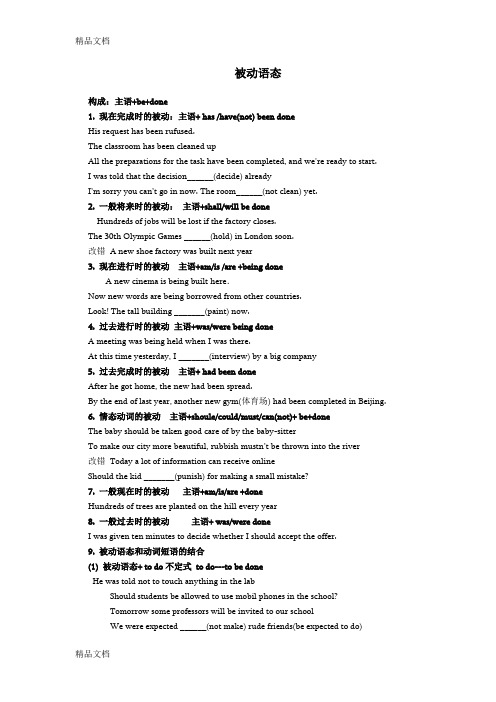
被动语态构成:主语+be+done1. 现在完成时的被动:主语+ has /have(not) been doneHis request has been rufused.The classroom has been cleaned upAll the preparations for the task have been completed, and we're ready to start.I was told that the decision______(decide) alreadyI’m sorry you can’t go in now. The room______(not clean) yet.2. 一般将来时的被动:主语+shall/will be doneHundreds of jobs will be lost if the factory closes.The 30th Olympic Games ______(hold) in London soon.改错A new shoe factory was built next year3. 现在进行时的被动主语+am/is /are +being doneA new cinema is being built here.Now new words are being borrowed from other countries.Look! The tall building _______(paint) now.4. 过去进行时的被动主语+was/were being doneA meeting was being held when I was there.At this time yesterday, I _______(interview) by a big company5. 过去完成时的被动主语+ had been doneAfter he got home, the new had been spread.By the end of last year, another new gym(体育场) had been completed in Beijing.6. 情态动词的被动主语+shoule/could/must/can(not)+ be+doneThe baby should be taken good care of by the baby-sitterTo make our city more beautiful, rubbish mustn’t be thrown into the river改错Today a lot of information can receive onlineShould the kid _______(punish) for making a small mistake?7. 一般现在时的被动主语+am/is/are +doneHundreds of trees are planted on the hill every year8. 一般过去时的被动主语+ was/were doneI was given ten minutes to decide whether I should accept the offer.9. 被动语态和动词短语的结合(1) 被动语态+ to do不定式to do---to be doneHe was told not to touch anything in the labShould students be allowed to use mobil phones in the school?Tomorrow some professors will be invited to our schoolWe were expected ______(not make) rude friends(be expected to do)In order not_______(recognize), he hide himself secretly(in order to do/in order not to do) (2) 被动语态+ doing doing---being doneHe prevented his son from being affected by the bad weatherHe told a lie to the teacher instead of _______(punish)Wearing a hat and walking in a hurry, he avoided_______(recognize)10. 注意(1)make sb do 的被动结构为:sb be made to doHe was made to work for ten hours a day.(2)see\hear\find\watch sb do 的被动结构为:sb be seen\heard\found\watched to do He was seen to watch the foolball every weekendsee\hear\find\watch sb doing的被动结构为:sb is\was seen\heard\found\watched doingA man was found lying on the side of the road.(3) get/have+done 使...被做He tried to get his work______(recognize) by the medical professionWatch out for the fire, or you will get burnt常见短语get married get hurt get injured get lost get drunk get paid(4) 主动形式表被动(即没有被动语态的情况)感官动词smell taste feel sound lookThe soup tastes deliciousI feel good today and I will be better tomorrow.表示主语特征,状态的动词wash write sell readThe kind of cloth washes wellThe newly bought pen writes______ (good)This kind of snack smells_____(good) and sells______(good)表示开始,结束类的动词start begin open close finish stop end等Classes begin at half past eightThe shop_____(close) at 9 pm .改错The meeting was ended with a song表示需要意思的词need require 等need doing=need to be donerequire doing=require to be doneThe desk needs repairing(to be repaired)表示值得意思的词worthsth be worth doing ......值得被做The museum is worth______(visit)表示发生意思的词happen take place 不用于被动语态Great changes have taken place in our hometown in the past ten years改错We need to think why it was happened in some places and not in others改错1.A recorder is often use in our English class2.A new film be shown next week3.When did the house built?4.The boy was seen does homework in the room5, Has the letter be sent yet?6.You must turn off the light before you go to bed.(改被动)单选1. Paul doesn’t have to be made _____ He always works hard .A. learnB. to learnC. learnedD. learning2. Mary_____many songs at the party .A. heard singB. heard to singC. was heard singD. was heard to sing3. He was seen_____ something from the shop .A. stealB. to stealC. to be stolenD. stealing4. The rivers smells terrible . People must _____dirty things into it .A. be stopped to throwB. be stopped from throwingC. stop to throwD. stop form throwing5. — Do you like the flower ? — Yes , it _____ sweet .A. is smellingB. smeltC. is smeltD. smells6. The light in the room _____before you leave .A. must turn ofB. will turn offC. are turnedD. must be turned off7. The bridge_____in three weeks .A. will buildB. is builtC. will be builtD. builds8. The old men and the children must_____ in our country .A. take good careB. be taken good careC. take good care ofD. be taken good care of9. We____that the English test _____next Monday .A. are told , givesB. tell , will giveC. are told , will be givenD. told , is going to be given10. Great changes____place in China since 1978 .A. have been takenB. have takenC. has been takenD. took11 ____ the red pencil-box ____by your father last week ?A. Has , boughtB. Was , boughtC. Does , buyD. Did , buy12.____trees usually ____in April ?A. Have , plantedB. Are , plantedC. Do , plantD. Were , planted13. When we got there , the broken road____repaired .A. is beingB. was beingC. has beenD. had been14. That building____ now .A. is buildingB. is builtC. is being builtD. builds15. These books____well .A. sellsB. are being soldC. are soldD. sell16. The boy____lost on his way home yesterday .A. gotB. isC. getsD. has17. More trees____ next year .A. will be plantedB. will plantC. have plantedD. are planting18. She has____ by her classmates .A. laughedB. laughed atC. been laughedD. been laughed at19. Have you moved into the new house ?Not yet . The rooms _____(paint)now .20. Look ! A big modern bridge________(build)over the river .21. Now he ______(be)asked if the meeting___________(hold)next Friday .22. The pictures__________(take)by Jack tomorrow .23. The room ________(paint)now .24. The novel________(translate)into many languages since it was published .25. The film_________(show)again next week .26. Kids__________(ask) not to play near the fire and the lake.After the news of the accdent was reported, other newspapers began to be required to catch exciting information about it. And a number of gossip articles were being written , even some reporters had been asked to go to the accident place to interview the witness(目击者). And soon some details of the accident will be discovered.。
被动语态语法练习教学设计教案

被动语态语法练习教学设计教案
目标
本节课的目标是教授学生被动语态的使用和运用,使他们能够准确地理解和运用被动语态。
教学内容
1. 被动语态的定义和特点
2. 被动语态的结构和形式
3. 被动语态的使用场景和应用
4. 被动语态的练和巩固
教学步骤
步骤一:引入
1. 通过展示一段使用被动语态的句子,引导学生了解被动语态的存在和作用。
2. 介绍被动语态的定义和特点。
步骤二:讲解
1. 分析被动语态的结构和形式,包括助动词的使用和动词变化。
2. 通过实例解释被动语态的使用场景和应用。
步骤三:练
1. 准备一些使用被动语态的句子,让学生根据语境选择正确的
动词形式。
2. 组织学生进行配对对话,使用被动语态进行交流。
步骤四:巩固
1. 提供一些练题,让学生用被动语态改写句子。
2. 分享一些常用的被动语态的表达方式和句型。
教学评估
在练和巩固环节中,教师可以观察学生的表现并进行评估。
评
估的方式可以包括口头回答问题、书面作业等。
教学材料
- 展示投影仪或白板
- 练题和答案解析
- 被动语态相关的例句和句型
教学延伸
1. 鼓励学生在写作中尝试使用被动语态,提高语言表达的多样性和准确性。
2. 引导学生阅读和分析使用被动语态的文章,提高阅读理解和写作能力。
参考资源。
被动语态的教案
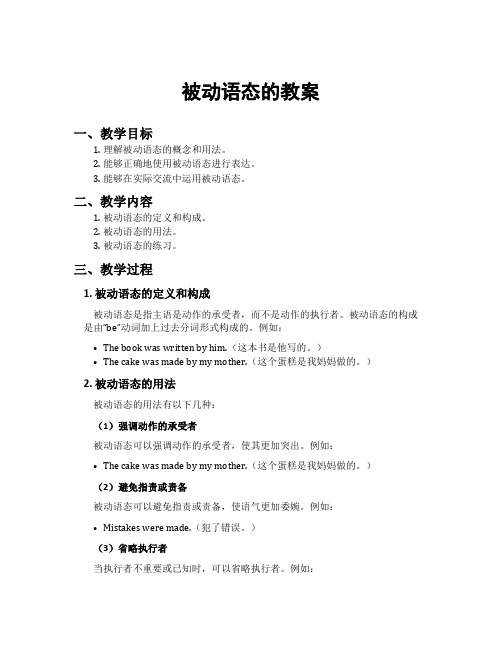
被动语态的教案一、教学目标1.理解被动语态的概念和用法。
2.能够正确地使用被动语态进行表达。
3.能够在实际交流中运用被动语态。
二、教学内容1.被动语态的定义和构成。
2.被动语态的用法。
3.被动语态的练习。
三、教学过程1. 被动语态的定义和构成被动语态是指主语是动作的承受者,而不是动作的执行者。
被动语态的构成是由“be”动词加上过去分词形式构成的。
例如:•The book was written by him.(这本书是他写的。
)•The cake was made by my mother.(这个蛋糕是我妈妈做的。
)2. 被动语态的用法被动语态的用法有以下几种:(1)强调动作的承受者被动语态可以强调动作的承受者,使其更加突出。
例如:•The cake was made by my mother.(这个蛋糕是我妈妈做的。
)(2)避免指责或责备被动语态可以避免指责或责备,使语气更加委婉。
例如:•Mistakes were made.(犯了错误。
)(3)省略执行者当执行者不重要或已知时,可以省略执行者。
例如:•The car was stolen.(这辆车被盗了。
)(4)表示客观事实被动语态可以表示客观事实,使语气更加客观。
例如:•The building was destroyed in the earthquake.(这座建筑在地震中被摧毁了。
)3. 被动语态的练习请根据下面的句子,改写成被动语态。
1.They are building a new hospital in the city.(在城市里他们正在建造一座新医院。
)2.The teacher gave us a lot of homework.(老师给了我们很多作业。
)3.The company will launch a new product next month.(公司将在下个月推出一款新产品。
)4.The police caught the thief last night.(警察昨晚抓住了小偷。
被动语态专题复习预习提纲
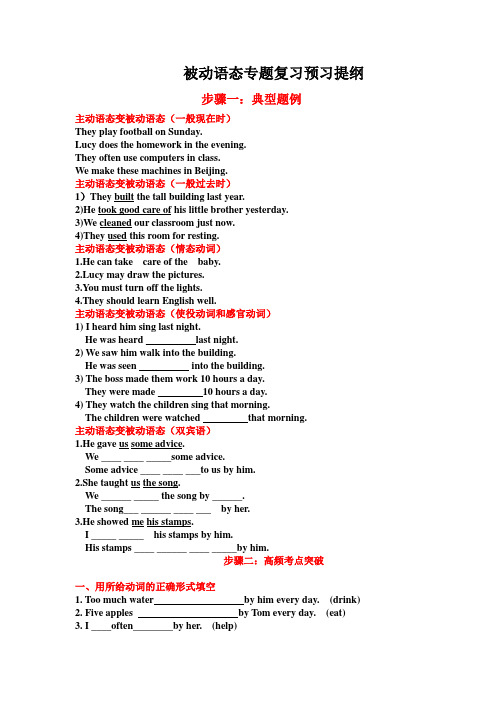
被动语态专题复习预习提纲步骤一:典型题例主动语态变被动语态(一般现在时)They play football on Sunday.Lucy does the homework in the evening.They often use computers in class.We make these machines in Beijing.主动语态变被动语态(一般过去时)1)They built the tall building last year.2)He took good care of his little brother yesterday.3)We cleaned our classroom just now.4)They used this room for resting.主动语态变被动语态(情态动词)1.He can take care of the baby.2.Lucy may draw the pictures.3.You must turn off the lights.4.They should learn English well.主动语态变被动语态(使役动词和感官动词)1) I heard him sing last night.He was heard ____ last night.2) We saw him walk into the building.He was seen __________ into the building.3) The boss made them work 10 hours a day.They were made _________10 hours a day.4) They watch the children sing that morning.The children were watched _________that morning.主动语态变被动语态(双宾语)1.He gave us some advice.We ____ ____ _____some advice.Some advice ____ ____ ___to us by him.2.She taught us the song.We ______ _____ the song by ______.The song___ ______ ____ ___ by her.3.He showed me his stamps.I _____ _____ his stamps by him.His stamps ____ ______ ____ _____by him.步骤二:高频考点突破一、用所给动词的正确形式填空1. Too much water by him every day. (drink)2. Five apples by Tom every day. (eat)3. I ____often________by her. (help)4.She ____often ______by me. ( hit)二、用be的正确形式填空1.Many trees ______planted by us every year.2.1000 trees ______planted by us last year.5.A knife(小刀) _________ used to cut apples.6. The air(空气) _________ often polluted .7.The rooms ________cleaned evry day.8. The students _______ asked to have breakfast.9.They_______ encouraged to study hard in the past.10.Not only he but also I _____ punished(惩罚)last night.三、句型转换1. Many trees are planted by people every year.Many trees____________ by people every year.(变否定句)______many trees _______by people every year?(变一般凝问句)What ________by people every year?(对many trees划线提问)__________many trees __________by every year?(对people划线提问)By ________many trees _______every year?Many trees are planted by people every year, ____________?(变反意凝问句)People __________many trees every year. (变主动语态)2.We don’t speak Japanese at school.(被动语态)Japanese ______ ________ by us at school.3. The desk is made by Tom.(主动语态)Tom _________ the desk.4.Tom, be, by, the model plane, make (连词成句)四、英汉互译1.她是由我帮助的.2.她受到了帮助.3.南方种水稻.4.山上种了很多树.步骤三:权威中考预测( )1.The river smells terrible. People must __ dirty thing into it.(中考题)A be stopped to throwB be stopped from throwingC stop to throwD stop from throwing( )2.This book __ often __from the library.(中考题)A aren’t take awayB taken awaC isn’t taken awayD be taken away3.He ____ _____ (tell) to return his books to the library yesterday. (中考题)4. People there planted many trees last year.many Trees _____ _____ by people there last year. (中考题)5. They grow vegetables on the farm.The vegetables _______ ______on the farm(中考题)。
- 1、下载文档前请自行甄别文档内容的完整性,平台不提供额外的编辑、内容补充、找答案等附加服务。
- 2、"仅部分预览"的文档,不可在线预览部分如存在完整性等问题,可反馈申请退款(可完整预览的文档不适用该条件!)。
- 3、如文档侵犯您的权益,请联系客服反馈,我们会尽快为您处理(人工客服工作时间:9:00-18:30)。
被动语态专练(简单)被动语态练习[各种时态的被动形式](1) 一般现在时: am, is, are + done(2) 一般过去时: was, were + done(3) 情态动词: can/could/may/must/should be +done*(4) 一般将来时: will be/be going to be + done*(5) 进行时: am, is, are, was, were being + done*(6) 完成时: have/has been + done一、用read的被动语态填空。
1. A book ______________ by Tom every week2. A book ______________ by Tom last week.3. A book ______________ by Tom next week.4. A book ______________ by Tom for a week.5. A book ______________ by Tom while we were visiting him.6. A book might _________ by Tom.二、单项选择。
( )1. Our TV set _____ yesterday.A. is repairedB. was repairedC. has been repairedD. repaired( )2. A wonderful English talk _____ by Mr Liu tomorrow.A. has been givenB. is givenC. is being givenD. will be given( )3. Mr Li , you _____ on the phone.A. are wantedB. were wantedC. are being wantedD. will be wanted( )4. This maths problem _____ out by little Tom.A. can be easily workB. can easily be workedC. can is easily workedD. can easily worked ( )5. The monkeys ______ to the zoo tomorrow morning.A. may be sendB. may will sentC. may be sentD. is going to send( )6. The baby ____ when Mother was out.A. looked after wellB. was looked wellC. is well looked afterD. was well looked after( )7. In the past ten year, a lot of new buildings _____ in our city.. A. are put up B. have put up C. have been put D. have been put up( )8. People have come to know that their health must ______.A. pay more attentionB. pay more attention toC. be paid more attentionD. be paid more attention to ( )9. The children ____ a beautiful picture by the teacher in the classroom.A. were shownB. were shown toC. was shownD. was shown to( )10. A beautiful picture ____ the children in the classroom.A. were shownB. were shown toC. was shownD. was shown to( )11. Mr Brown ____ take the medicine twice a day.A. told toB. was told toC. toldD. was told( )12. The boys ____ copy the new words ten times before they went home.A. were madeB. were made toC. was madeD. was made to( )13. Mary ____ do morning exercises on the playground.A. saw toB. was saw toC. was seen toD. was seen( )14. A man ____ cry for help last night.A. was heard toB. was heardC. was hear toD. heard to( )15. Tom ____ watch TV after he finishes his homeworkA. will let toB. will be allowedC. will be letD. will be allowed to.( )16. Great changes ____ in the village since then.A . have been taken place B. took place C. have taken place D. were taken place( )17. In the last few years Beijing ____ greatly.A. has changedB. has been changedC. changedD. was changed( )18. He ____ much better today.A. is feltB. feltC. is being feltD. feels( )19. Vegetables, eggs and meat ____ in this shop.A. sellsB. soldC. is soldD. are sold( )20. What kind of books ____ well?A. sellsB. soldC. is soldD. are sold三、将下列句子变成被动语态将主动语态中的宾语变成被动语态的主语将谓语部分变成被动形式(注意人称和数要做相应变化,时态不变) 将主动语态中的主语变成被动语态的宾语(前面加by)1. Mother gave me a new desk as a present.2. I made my little brother a model ship last week.3. Ann must finish her homework first.4. He often passes me my pen.5. Did he buy you the book you wanted?6. I saw him go into the classroom.7. Who often takes care of the old granny?8. You could give him a ticket to a ball game.9. We must keep our classroom clean.10. You should water the flowers every day.11. They may invite him to the party.12. The teacher will ask you some questions.13. Bill looks after a cat carefully.14. She left some money on the table.15. I have learned 500 English words for two years.四、用所给动词的正确形式填空。
1. She __________(tell) the good news as soon as it arrived.2. A lot of work __________(do) for the poor kids in the past few years.3. The book __________(write) by the young girl.4. The fruit from Taiwan __________(sell) well.5. We must ___________(allow) to grow hair long.6. My shoes need __________(mend).7. When it ___________(rain) heavily outside, she ran out of the house.8. A new building ___________(build) at our school now.9. An earthquake ___________(take place) when people ____________(sleep) at midnight.10. The students were made ___________(hand) in their homework.五、同义句转换。
1. He sent an e-mail to me last week. An e-mail ________ ________ _______ me last week.2. You should water the flowers every day. The flowers _______ _______ ______ every day.3. My parents gave me ten minutes to make a decision. _________ ________ _________ ten minutes to make a decision.4. Someone saw her go upstairs last night. She _______ _______ _____ go upstairs last night.5. You must put away your books. Your books _______ _______ ______ away.6. Father will buy me a new computer if I get better grades. A new computer ________ ________ ________ ________ me if I get better grades.7. Nobody has ever visited the island. The island ________ ________ ________yet.8. She is taking care of the sick people. The sick people ________ _______ _______ _______ _______ by her.9. Do you know the boy whose name is Jack? Do you know the boy _________ ________ _________ Jack/_________ Jack?10. The box left on the train has been reported. The TV Station _______ ______ the box _______ _______ _______ on the train.六、汉译英。
